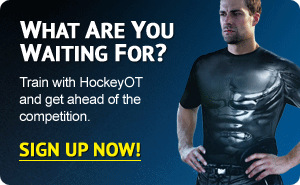What kind of shoes should you be wearing for your HockeyOT dryland training workouts? Many athletes choose the shoes that they see advertised on television or on the internet that there favorite player is promoting. But is that the best shoe to maximize your off-ice training?
Check out the video review below to see what shoes hockey training specialist Dr. Chad Moreau recommends for your workouts.
When choosing the correct shoe you should take into account a few factors:
1) What kind of surface will you be training on?
2) What kind of activities will be performed?
3) Do you have any injuries or functional limitations that will affect shoe selection?
Strength Training
Strength training is typically done indoors on a hard, flat surface. Typically, strength training involves the athlete performing exercises with external resistance that can include dumbbells and weighted barbells. This external loading requires the athlete to be wearing a shoe that is low to the surface and stable. A shoe that has an elevated heel via an air cushion or gel is a poor choice for strength training as it can lead to instability due to the lack of ground support. Also, an elevated heel can have a tendency to cause the athlete to drive forward at the knees during the squat exercise rather than using the proper technique of sitting back into the hips and engaging the hamstring and gluteal muscle groups (the skating muscles). I have personally witnessed the air pocket on a pair of Nike Air shoes pop and slightly deflate during a heavy power squat repetition! Good shoe choices for strength training would be any low profile athletic shoe that makes the athlete feel close to the surface and stable.
My top choices for strength training:
1) Vibram Five Finger Komodo Sport $110
-when you get used to this shoe (look and feel!), you will feel very connected to the training surface
-most of my pro players now use these shoes for strength training
2) Nike Free Trainer $110
-feels like a more traditional athletic shoe but without the bulky air or gel heel technology
-the sole of this shoe has a tendency to tear with aggressive use
3) New Balance Minimus $72.99
-good for athletes with wide feet as they come in 2E
-I feel like my feet have a tendency to slide around in these shoes
Speed/Agility/Endurance Training
Speed and agility training can be performed on asphalt, gravel, rubberized track, artificial turf, hard-packed dirt or grass. Many elite hockey players spend a lot of time with their feet and ankles strapped into an ice hockey skate. This can cause a loss of ankle, foot and toe mobility. As a result, when they walk and run, the stiffness in their ankles and feet can create injuries in the knees, hips and even low back. Many hockey players benefit from minimalist or barefoot shoes that encourage foot and ankle mobility when performing speed and agility training. Another advantage to minimalist shoes is that the athlete feels close to the surface when changing directions which can help reduce ankle sprains. Typically, the barefoot shoes are better on less firm surfaces such as rubberized track, turf and grass (see my top choice for strength training above). Harder surfaces such as asphalt, gravel and hard-packed dirt may require a more traditional training shoe.
My top choices for speed & agility training on HARD surfaces:
1) Nike Free Trainer $110
2) New Balance Minimus $72.99
3) New Balance Cross Trainer $79.99
-traditional cross-trainer that is also available in wide sizes
Check out the video review below to see what shoes hockey training specialist Dr. Chad Moreau recommends for your workouts.
Dr. Chad Moreau is the President of HockeyOT.com, an online training site dedicated to improving the fitness level of hockey players of all levels. He was the former Strength & Conditioning/Nutrition Consultant for the Edmonton Oilers (NHL) and the Long Beach Ice Dogs (ECHL). For more information please visit hockeyot.com.



















